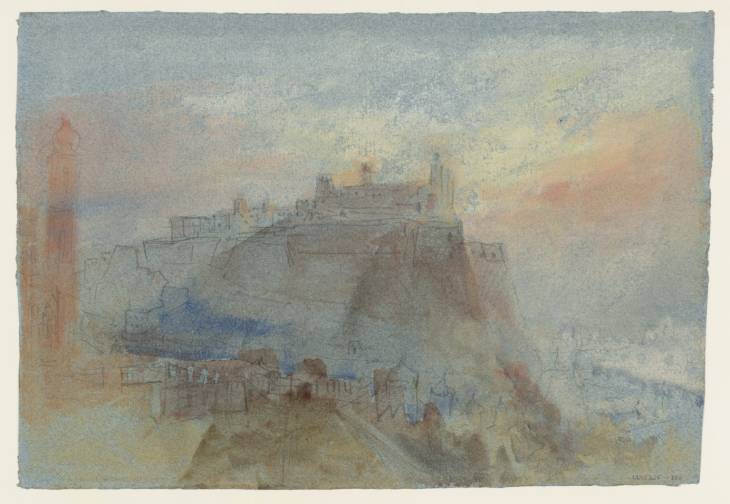Joseph Mallord William Turner The Marienberg and Würzburg from the Terrace of the Käppele 1840
Joseph Mallord William Turner,
The Marienberg and Würzburg from the Terrace of the Käppele
1840
Joseph Mallord William Turner 1775–1851
The Marienberg and Würzburg from the Terrace of the Käppele 1840
D36157
Turner Bequest CCCLXIV 300
Turner Bequest CCCLXIV 300
Pencil, watercolour and gouache on blue wove paper, 191 x 278 mm
Blind-stamped with Turner Bequest monogram towards bottom right
Stamped in black ‘CCCLXIV – 300’ bottom right
Blind-stamped with Turner Bequest monogram towards bottom right
Stamped in black ‘CCCLXIV – 300’ bottom right
Accepted by the nation as part of the Turner Bequest 1856
References
1909
A.J. Finberg, A Complete Inventory of the Drawings of the Turner Bequest, London 1909, vol.II, p.1198, CCCLXIV 300, as ‘Fortress’, after about 1830.
1974
Andrew Wilton in Martin Butlin, Wilton and John Gage, Turner 1775–1851, exhibition catalogue, Royal Academy, London 1974, p.157 under no.559, as 1840.
1995
Cecilia Powell, Turner in Germany, exhibition catalogue, Tate Gallery, London 1995, p.174 under no.105, as Würzburg subject, 1840.
As Cecilia Powell first recognised, albeit in passing,1 this is a view of Würzburg from the terrace of the Käppele pilgrimage church, framed by the southernmost of the twin Baroque towers on its east front, looking down from the Nikolausberg over the valley of the River Main. Directly to the north is the Marienberg fortress, with the pale city loosely indicated to the north-east on the opposite bank. Domed pavilions containing sculptures of the Stations of the Cross line the long balustraded sequence of steps and terraces approaching the church. The shallow diagonal edge of the deep shadow across the fortress, with only part of it illuminated against the glowing sky, suggests an early morning effect.
Turner was recorded in Würzburg on 23 September 1840, and after rounding off the southern German pages of his Venice; Passau to Würzburg sketchbook with a view from his hotel (Tate D31376; Turner Bequest CCCX 51), he filled about a quarter of his tour’s final book, Würzburg, Rhine and Ostend, with a thorough survey in and around the picturesque city; see under Tate D30596 (Turner Bequest CCCIII 71). There are two watercolour and gouache studies on blue and grey papers (respectively the present work and Tate D36158; Turner Bequest CCCLXIV 301), one on blue in pencil alone (D25101; CCLXII 1), and two variant pencil drawings on larger sheets of white (D34515, D34516; CCCXLIV 151, 152). All show the Marienberg on the left, with the city below to the east, as do two watercolours (currently untraced;2 National Museum Wales, Cardiff3), ‘probably painted over pencil sketches drawn on the spot’, as Powell has noted.4
Powell pictured ‘a point when Turner could bear the confinement of his small sketchbook no longer’,5 and the views on the separate sheets are independent of those in the Würzburg, Rhine and Ostend book. The Marienberg appears many times within it, but only D30620 (CCCIII 83) shows it with the city from the south, from down on the opposite bank of the Main; D30630 (CCCIII 88) is among sketches showing the distant Käppele beyond the fortress to the south-west, looking back in the opposite direction.
D36158, the variant on grey paper mentioned above, shows the scene brightly illuminated by early afternoon sunlight, with various features highlighted with white gouache, from the Stationsweg down the hill. The pencil work on all three coloured sheets is similarly detailed, but they are not reliant on each other, their foregrounds indicating that they were begun from slightly different viewpoints. Whether fortuitously or not, the present sheet and D25101 are of mid-toned blue paper rather that the grey Turner customarily used on this tour (see under D36158), which suited the richer, darker colours he subsequently applied. Blue paper, similar to sheets he used extensively on other occasions, was only used for a handful of works associated with this tour; see the overall Introduction, and the technical notes below.
Andrew Wilton, J.M.W. Turner: His Life and Work, Fribourg 1979, p.459 no.1321, as ‘Ehrenbreitstein and Coblenz’, c.1840, pl.242 (colour).
Technical notes:
The application of gouache is thick and creamy in the sky, where it has been dragged across the tooth of the paper; elsewhere the washes are thin and fluid, with small touches of scratching out in the foreground. Pencil has been used over the colour in places.
Although it is a soft greyish blue, Finberg had described the present sheet simply as ‘grey’ in his Inventory, placing it in numerical sequence with D36158, a variant actually on grey (see above), following their established link as consecutive nineteenth-century National Gallery exhibits.1 Before their subjects and dates had been firmly established, Andrew Wilton suggested a technical link between both variants among several ‘on the Rhine and at Botzen’ (Tate D36149–D36158; Turner Bequest CCCLXIV 292–301) and Venetian subjects of 1840 on similar grey sheets;2 most have since been confirmed as from this tour, and are indeed on the same Bally, Ellen and Steart grey paper used in Venice (see the overall Introduction).
Verso:
Blank; stamped in black with Turner Bequest monogram over ‘CCCLXIV – 300’ towards bottom right.
Matthew Imms
September 2018
How to cite
Matthew Imms, ‘The Marienberg and Würzburg from the Terrace of the Käppele 1840 by Joseph Mallord William Turner’, catalogue entry, September 2018, in David Blayney Brown (ed.), J.M.W. Turner: Sketchbooks, Drawings and Watercolours, Tate Research Publication, December 2019, https://www

